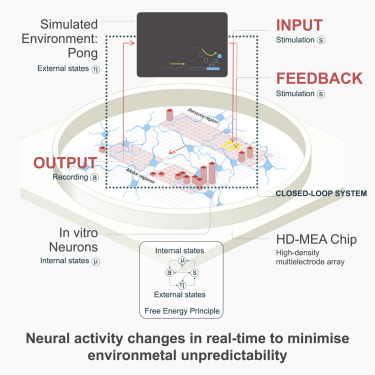Oct 14 2022
Brain Cells Playing Pong
 This is definitely the neuroscience news of the week. It shows how you can take an incremental scientific advance and hype it into a “new science” and a breakthrough and the media will generally just eat it up. Did scientists teach a clump of brain cells to play the video-game pong? Well, yes and no. The actual science here is fascinating and very interesting, but I fear it is generally getting lost in the hype.
This is definitely the neuroscience news of the week. It shows how you can take an incremental scientific advance and hype it into a “new science” and a breakthrough and the media will generally just eat it up. Did scientists teach a clump of brain cells to play the video-game pong? Well, yes and no. The actual science here is fascinating and very interesting, but I fear it is generally getting lost in the hype.
This is what the researchers actually did – they cultured mouse or human neurons derived from stem cells onto a multi-electrode array (MEA). The MEA can both read and stimulate the neurons. Neurons spontaneously network together, so that’s what these neurons did. They then stimulated the two-dimensional network of neurons either on the left or the right and at different frequencies, and recorded the network’s response. If the network responded in a way the scientists deemed correct, then they were “rewarded” with a predictable further stimulation. If their response was deemed incorrect, they were “punished” with random stimulation. Over time the network learned to produce the desired response, and its learning accelerated. Further, human neurons learned faster than mouse neurons.
Why did this happen? That is what researchers are trying to figure out, but the authors speculate that predictable stimulation allows the neurons to make more stable connections, while random stimulation is disruptive. Therefore predictable feedback tends to reinforce whatever network pattern results in predictable feedback. In this way the network is behaving like a simple AI algorithm.
How did these networks do? Better than chance, but otherwise not very well. But clearly the network “learned”, meaning that its pattern of connections tended toward stimulus response that produced the desired outcome. Where does the video-game Pong come it? That was it – did you miss it? Pong was essentially just a metaphor for what was happening. When the stimulus was on the left, then the ball was on the left, and the faster the stimulus the closer the ball was. The response of the network was interpreted as moving the paddle, and within certain parameters it was deemed to hit or miss the ball. Is this “playing pong”? I guess that’s a matter of perception, but I would say no. Rather, random firings that happen to be in the correct direction were reinforced by predictable stimulation. But sure, you could connect the MEA to a computer and graphically represent the input and output of the network as a game of pong, or probably in hundreds of other ways.
Far more misleading than the Pong metaphor, however, is the claim represented in the title of the paper – In vitro neurons learn and exhibit sentience when embodied in a simulated game-world. “Sentience?” I don’t think so – at no point is this flat network of neurons thinking or feeling anything, nor does it have any idea what it is doing, and it’s a bit of a stretch to consider it “embodied”? What the researchers did was close the loop on stimulus and response by allowing the network’s response to dictate further stimulus. This has already been done in vivo, they were the first to do it in vitro. Hardly a breakthrough, and completely predictable. But they did develop a nice system that can be useful for further research. Again, I have to point out that neuroscientists have been plating neurons on MEAs for decades. Closing the loop of input and output in vitro was the new bit.
What is fascinating about these results (again, not new, but interesting and worth pointing out) is how spontaneously and easily neurons network together and can start reacting collectively to their environment. Of course, they have had about 500 million years of evolution to develop these functions. That’s what neurons do – they wire together, they fire together, and they change their firing based on stimulus. Further, even very simple networks can leverage very basic functions (like the strength of their connections) in order to start to encode information, and respond differentially to external stimuli. A creature with such a simple network could learn to move toward food, away from toxins, toward light, or away from predators.
Even at this very basic level, there could be some evolutionary advantage to primitive networks of cells that are a bit more electrically active than other cells. Over time, each incremental improvement in the cells themselves or the networks they form could provide further advantages to the organisms that posses them – all the way up to a human brain. Flat networks eventually become three-dimensional. Networks can then develop to have some predetermined structure and therefore activity. That structure can also map to the body of the organism during development. Eventually you have multiple networks networking together, with each network becoming more and more specialized. Complexity is increasing over time at the molecular level (neurotransmitters), the cellular level, the network level, the whole organ level, and the whole organism level.
What research like this does is strip down neurological function to the simplest networks – just a flat plate of neurons. Even at this remarkably simple level, networks can spontaneously form, and all they need is some input and output, and they can start learning and carrying out some function. Pretty remarkable.






